Sarbanes-Oxley Act: Requirements for Public Companies and Partnerships
VerifiedAdded on 2023/04/26
|5
|1173
|326
Essay
AI Summary
This essay provides an overview of the Sarbanes-Oxley Act (SOX) and its requirements for companies, particularly those offering shares to the public. It details key provisions of the act, including sections 302 and 404 related to financial statement accuracy and internal controls. The essay emphasizes the importance of independent audit committees, codes of ethics, and regulatory compliance for companies going public, highlighting factors such as board composition and disclosure controls. It contrasts the regulatory burden on public companies with the relative freedom of partnership firms, which are not subject to the same requirements for raising capital or establishing audit committees and ethical policies. The essay concludes by underscoring the time and cost associated with SOX compliance but emphasizes the benefits for a smooth initial public offering process.
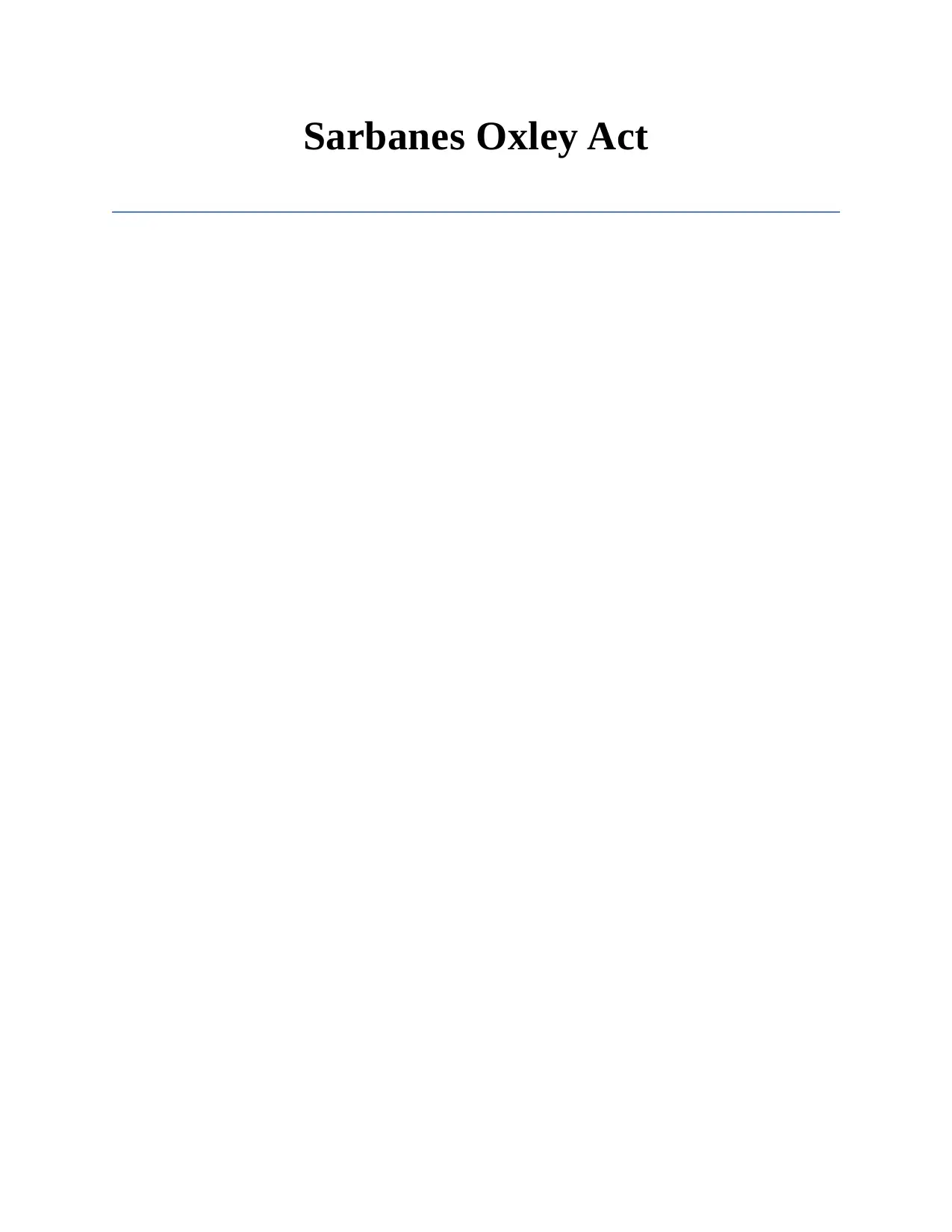
Sarbanes Oxley Act
Paraphrase This Document
Need a fresh take? Get an instant paraphrase of this document with our AI Paraphraser
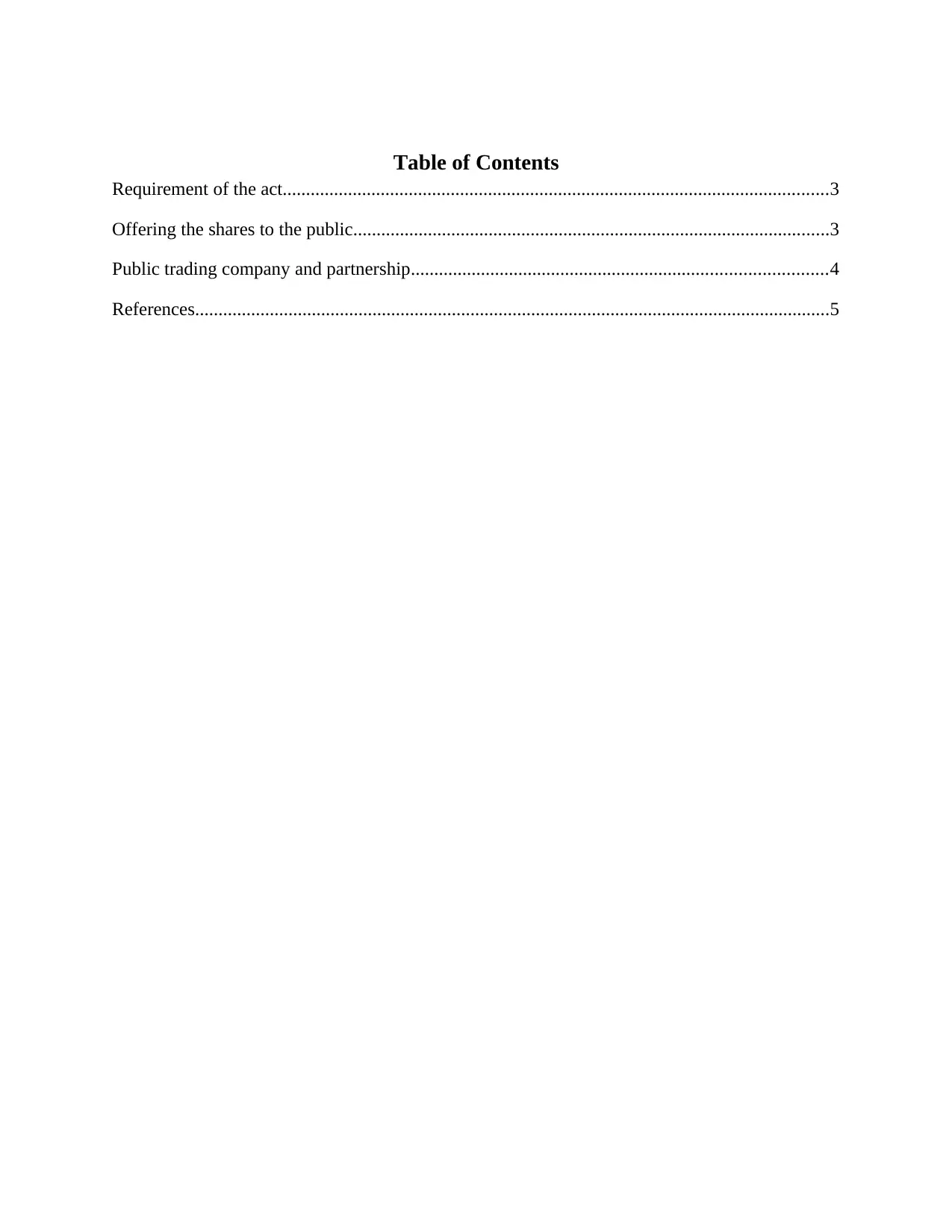
Table of Contents
Requirement of the act.....................................................................................................................3
Offering the shares to the public......................................................................................................3
Public trading company and partnership.........................................................................................4
References........................................................................................................................................5
Requirement of the act.....................................................................................................................3
Offering the shares to the public......................................................................................................3
Public trading company and partnership.........................................................................................4
References........................................................................................................................................5
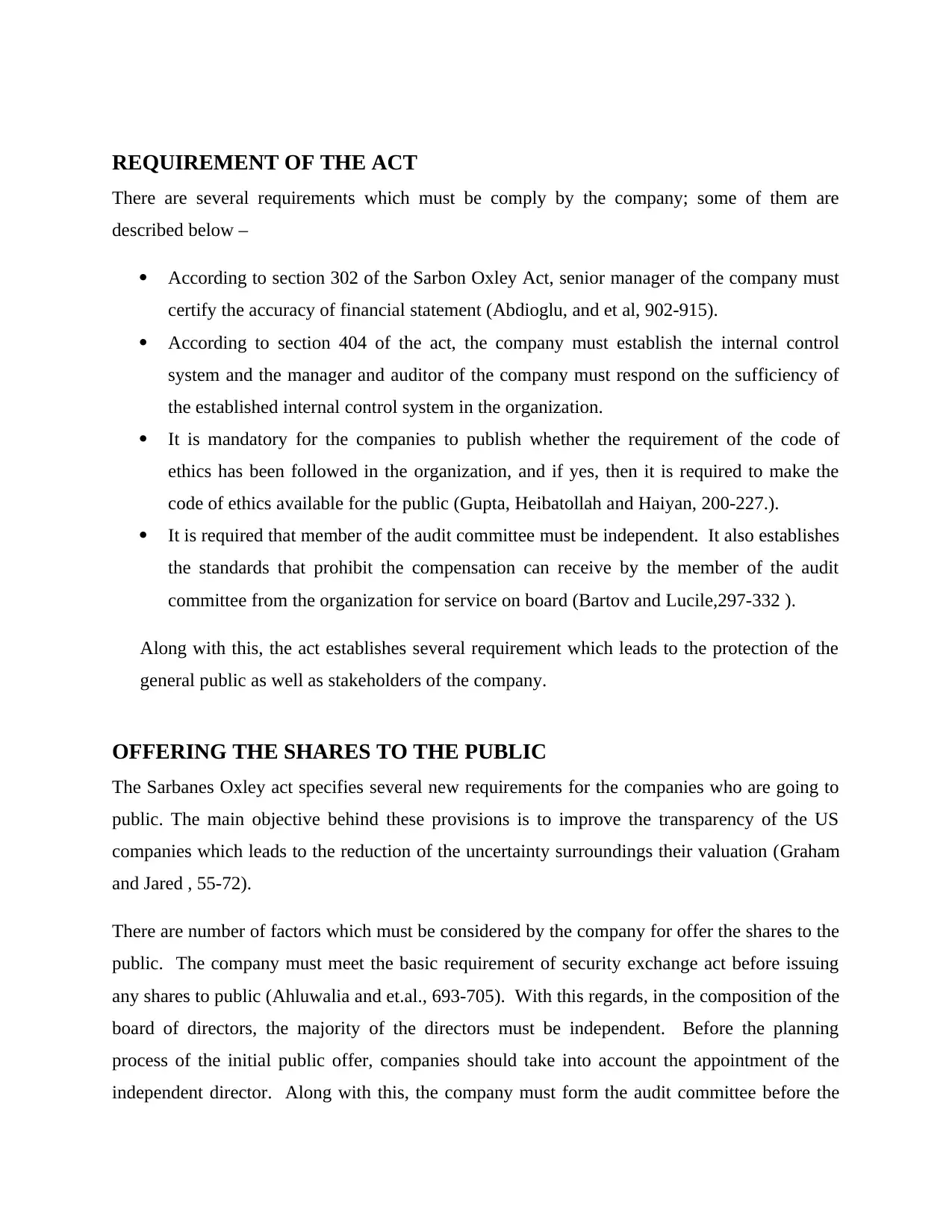
REQUIREMENT OF THE ACT
There are several requirements which must be comply by the company; some of them are
described below –
According to section 302 of the Sarbon Oxley Act, senior manager of the company must
certify the accuracy of financial statement (Abdioglu, and et al, 902-915).
According to section 404 of the act, the company must establish the internal control
system and the manager and auditor of the company must respond on the sufficiency of
the established internal control system in the organization.
It is mandatory for the companies to publish whether the requirement of the code of
ethics has been followed in the organization, and if yes, then it is required to make the
code of ethics available for the public (Gupta, Heibatollah and Haiyan, 200-227.).
It is required that member of the audit committee must be independent. It also establishes
the standards that prohibit the compensation can receive by the member of the audit
committee from the organization for service on board (Bartov and Lucile,297-332 ).
Along with this, the act establishes several requirement which leads to the protection of the
general public as well as stakeholders of the company.
OFFERING THE SHARES TO THE PUBLIC
The Sarbanes Oxley act specifies several new requirements for the companies who are going to
public. The main objective behind these provisions is to improve the transparency of the US
companies which leads to the reduction of the uncertainty surroundings their valuation (Graham
and Jared , 55-72).
There are number of factors which must be considered by the company for offer the shares to the
public. The company must meet the basic requirement of security exchange act before issuing
any shares to public (Ahluwalia and et.al., 693-705). With this regards, in the composition of the
board of directors, the majority of the directors must be independent. Before the planning
process of the initial public offer, companies should take into account the appointment of the
independent director. Along with this, the company must form the audit committee before the
There are several requirements which must be comply by the company; some of them are
described below –
According to section 302 of the Sarbon Oxley Act, senior manager of the company must
certify the accuracy of financial statement (Abdioglu, and et al, 902-915).
According to section 404 of the act, the company must establish the internal control
system and the manager and auditor of the company must respond on the sufficiency of
the established internal control system in the organization.
It is mandatory for the companies to publish whether the requirement of the code of
ethics has been followed in the organization, and if yes, then it is required to make the
code of ethics available for the public (Gupta, Heibatollah and Haiyan, 200-227.).
It is required that member of the audit committee must be independent. It also establishes
the standards that prohibit the compensation can receive by the member of the audit
committee from the organization for service on board (Bartov and Lucile,297-332 ).
Along with this, the act establishes several requirement which leads to the protection of the
general public as well as stakeholders of the company.
OFFERING THE SHARES TO THE PUBLIC
The Sarbanes Oxley act specifies several new requirements for the companies who are going to
public. The main objective behind these provisions is to improve the transparency of the US
companies which leads to the reduction of the uncertainty surroundings their valuation (Graham
and Jared , 55-72).
There are number of factors which must be considered by the company for offer the shares to the
public. The company must meet the basic requirement of security exchange act before issuing
any shares to public (Ahluwalia and et.al., 693-705). With this regards, in the composition of the
board of directors, the majority of the directors must be independent. Before the planning
process of the initial public offer, companies should take into account the appointment of the
independent director. Along with this, the company must form the audit committee before the
⊘ This is a preview!⊘
Do you want full access?
Subscribe today to unlock all pages.

Trusted by 1+ million students worldwide
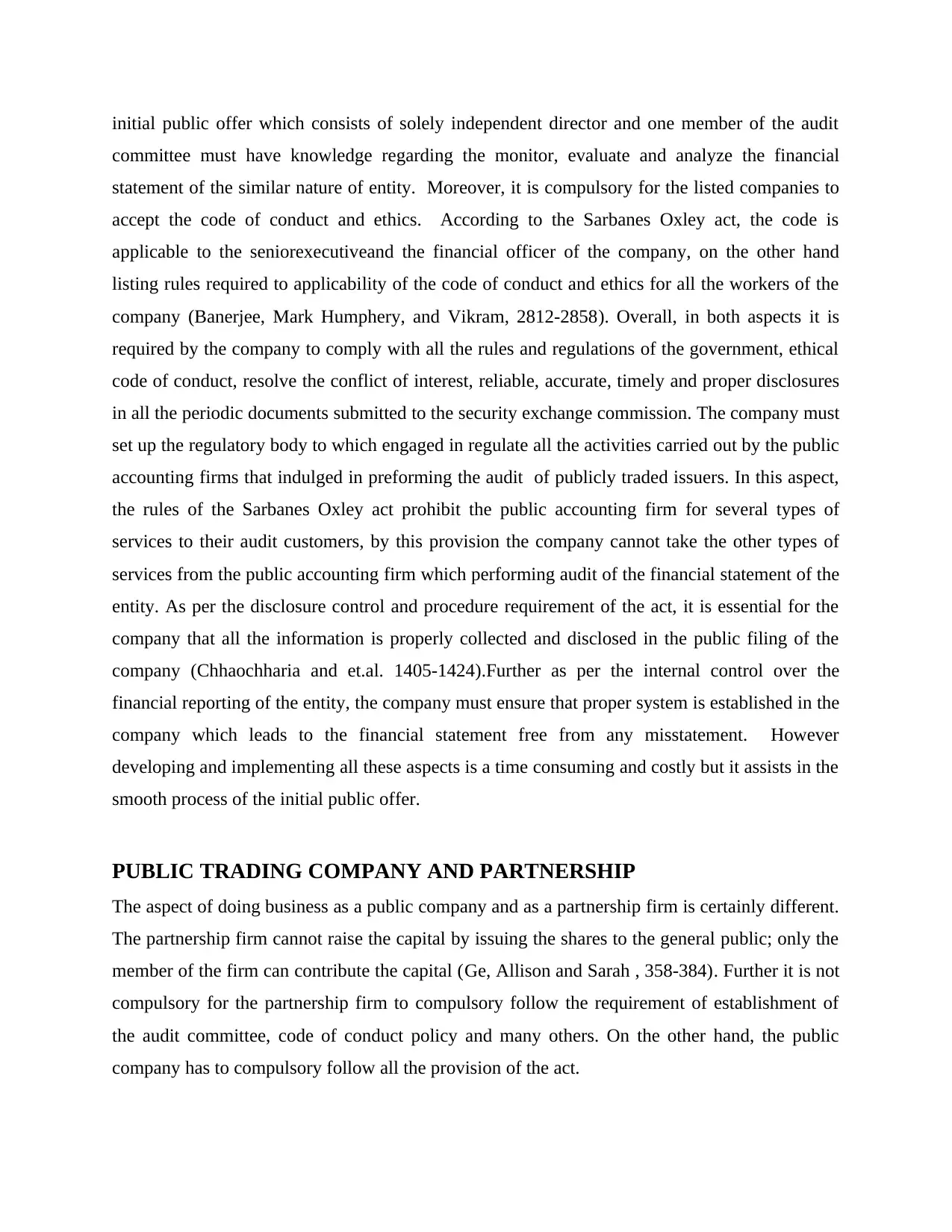
initial public offer which consists of solely independent director and one member of the audit
committee must have knowledge regarding the monitor, evaluate and analyze the financial
statement of the similar nature of entity. Moreover, it is compulsory for the listed companies to
accept the code of conduct and ethics. According to the Sarbanes Oxley act, the code is
applicable to the seniorexecutiveand the financial officer of the company, on the other hand
listing rules required to applicability of the code of conduct and ethics for all the workers of the
company (Banerjee, Mark Humphery, and Vikram, 2812-2858). Overall, in both aspects it is
required by the company to comply with all the rules and regulations of the government, ethical
code of conduct, resolve the conflict of interest, reliable, accurate, timely and proper disclosures
in all the periodic documents submitted to the security exchange commission. The company must
set up the regulatory body to which engaged in regulate all the activities carried out by the public
accounting firms that indulged in preforming the audit of publicly traded issuers. In this aspect,
the rules of the Sarbanes Oxley act prohibit the public accounting firm for several types of
services to their audit customers, by this provision the company cannot take the other types of
services from the public accounting firm which performing audit of the financial statement of the
entity. As per the disclosure control and procedure requirement of the act, it is essential for the
company that all the information is properly collected and disclosed in the public filing of the
company (Chhaochharia and et.al. 1405-1424).Further as per the internal control over the
financial reporting of the entity, the company must ensure that proper system is established in the
company which leads to the financial statement free from any misstatement. However
developing and implementing all these aspects is a time consuming and costly but it assists in the
smooth process of the initial public offer.
PUBLIC TRADING COMPANY AND PARTNERSHIP
The aspect of doing business as a public company and as a partnership firm is certainly different.
The partnership firm cannot raise the capital by issuing the shares to the general public; only the
member of the firm can contribute the capital (Ge, Allison and Sarah , 358-384). Further it is not
compulsory for the partnership firm to compulsory follow the requirement of establishment of
the audit committee, code of conduct policy and many others. On the other hand, the public
company has to compulsory follow all the provision of the act.
committee must have knowledge regarding the monitor, evaluate and analyze the financial
statement of the similar nature of entity. Moreover, it is compulsory for the listed companies to
accept the code of conduct and ethics. According to the Sarbanes Oxley act, the code is
applicable to the seniorexecutiveand the financial officer of the company, on the other hand
listing rules required to applicability of the code of conduct and ethics for all the workers of the
company (Banerjee, Mark Humphery, and Vikram, 2812-2858). Overall, in both aspects it is
required by the company to comply with all the rules and regulations of the government, ethical
code of conduct, resolve the conflict of interest, reliable, accurate, timely and proper disclosures
in all the periodic documents submitted to the security exchange commission. The company must
set up the regulatory body to which engaged in regulate all the activities carried out by the public
accounting firms that indulged in preforming the audit of publicly traded issuers. In this aspect,
the rules of the Sarbanes Oxley act prohibit the public accounting firm for several types of
services to their audit customers, by this provision the company cannot take the other types of
services from the public accounting firm which performing audit of the financial statement of the
entity. As per the disclosure control and procedure requirement of the act, it is essential for the
company that all the information is properly collected and disclosed in the public filing of the
company (Chhaochharia and et.al. 1405-1424).Further as per the internal control over the
financial reporting of the entity, the company must ensure that proper system is established in the
company which leads to the financial statement free from any misstatement. However
developing and implementing all these aspects is a time consuming and costly but it assists in the
smooth process of the initial public offer.
PUBLIC TRADING COMPANY AND PARTNERSHIP
The aspect of doing business as a public company and as a partnership firm is certainly different.
The partnership firm cannot raise the capital by issuing the shares to the general public; only the
member of the firm can contribute the capital (Ge, Allison and Sarah , 358-384). Further it is not
compulsory for the partnership firm to compulsory follow the requirement of establishment of
the audit committee, code of conduct policy and many others. On the other hand, the public
company has to compulsory follow all the provision of the act.
Paraphrase This Document
Need a fresh take? Get an instant paraphrase of this document with our AI Paraphraser
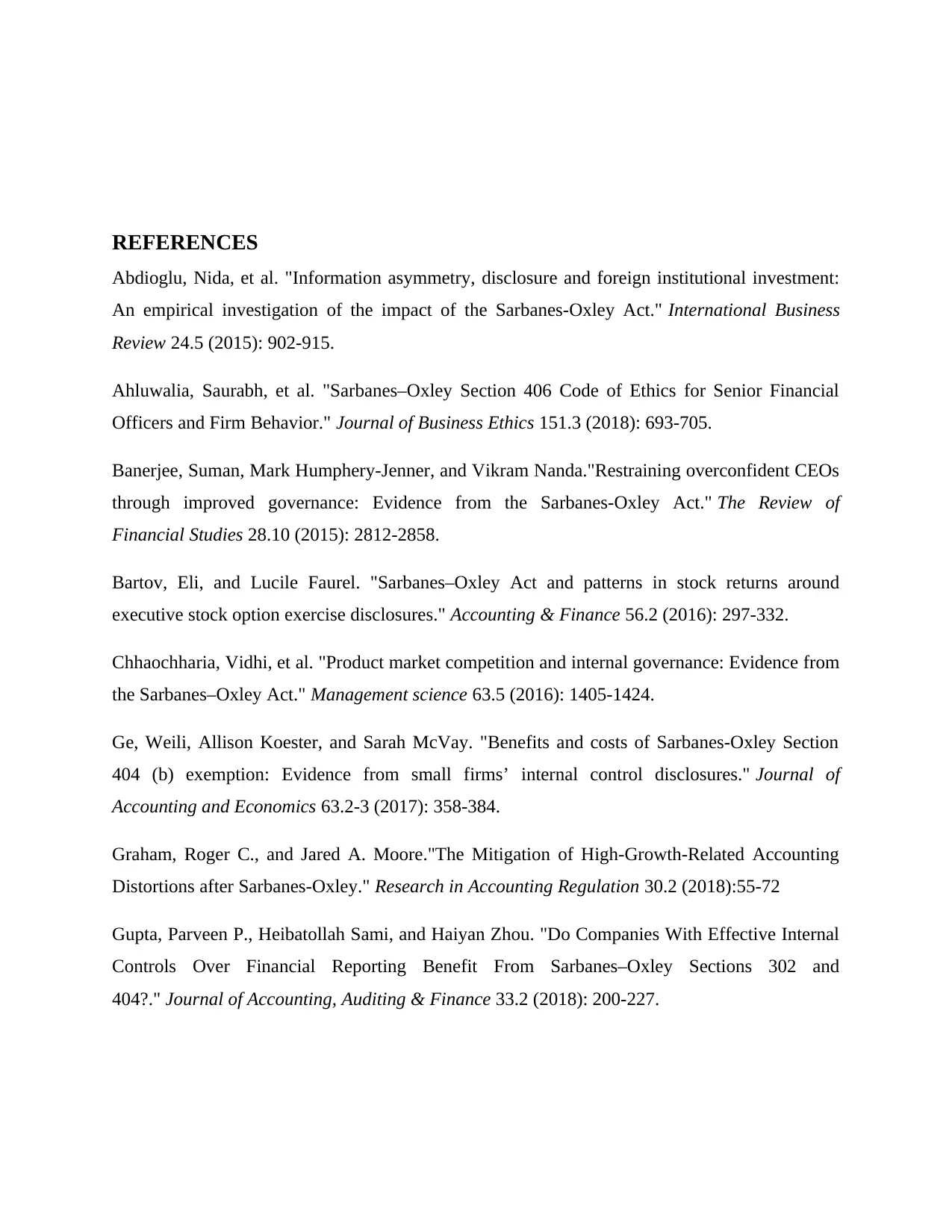
REFERENCES
Abdioglu, Nida, et al. "Information asymmetry, disclosure and foreign institutional investment:
An empirical investigation of the impact of the Sarbanes-Oxley Act." International Business
Review 24.5 (2015): 902-915.
Ahluwalia, Saurabh, et al. "Sarbanes–Oxley Section 406 Code of Ethics for Senior Financial
Officers and Firm Behavior." Journal of Business Ethics 151.3 (2018): 693-705.
Banerjee, Suman, Mark Humphery-Jenner, and Vikram Nanda."Restraining overconfident CEOs
through improved governance: Evidence from the Sarbanes-Oxley Act." The Review of
Financial Studies 28.10 (2015): 2812-2858.
Bartov, Eli, and Lucile Faurel. "Sarbanes–Oxley Act and patterns in stock returns around
executive stock option exercise disclosures." Accounting & Finance 56.2 (2016): 297-332.
Chhaochharia, Vidhi, et al. "Product market competition and internal governance: Evidence from
the Sarbanes–Oxley Act." Management science 63.5 (2016): 1405-1424.
Ge, Weili, Allison Koester, and Sarah McVay. "Benefits and costs of Sarbanes-Oxley Section
404 (b) exemption: Evidence from small firms’ internal control disclosures." Journal of
Accounting and Economics 63.2-3 (2017): 358-384.
Graham, Roger C., and Jared A. Moore."The Mitigation of High-Growth-Related Accounting
Distortions after Sarbanes-Oxley." Research in Accounting Regulation 30.2 (2018):55-72
Gupta, Parveen P., Heibatollah Sami, and Haiyan Zhou. "Do Companies With Effective Internal
Controls Over Financial Reporting Benefit From Sarbanes–Oxley Sections 302 and
404?." Journal of Accounting, Auditing & Finance 33.2 (2018): 200-227.
Abdioglu, Nida, et al. "Information asymmetry, disclosure and foreign institutional investment:
An empirical investigation of the impact of the Sarbanes-Oxley Act." International Business
Review 24.5 (2015): 902-915.
Ahluwalia, Saurabh, et al. "Sarbanes–Oxley Section 406 Code of Ethics for Senior Financial
Officers and Firm Behavior." Journal of Business Ethics 151.3 (2018): 693-705.
Banerjee, Suman, Mark Humphery-Jenner, and Vikram Nanda."Restraining overconfident CEOs
through improved governance: Evidence from the Sarbanes-Oxley Act." The Review of
Financial Studies 28.10 (2015): 2812-2858.
Bartov, Eli, and Lucile Faurel. "Sarbanes–Oxley Act and patterns in stock returns around
executive stock option exercise disclosures." Accounting & Finance 56.2 (2016): 297-332.
Chhaochharia, Vidhi, et al. "Product market competition and internal governance: Evidence from
the Sarbanes–Oxley Act." Management science 63.5 (2016): 1405-1424.
Ge, Weili, Allison Koester, and Sarah McVay. "Benefits and costs of Sarbanes-Oxley Section
404 (b) exemption: Evidence from small firms’ internal control disclosures." Journal of
Accounting and Economics 63.2-3 (2017): 358-384.
Graham, Roger C., and Jared A. Moore."The Mitigation of High-Growth-Related Accounting
Distortions after Sarbanes-Oxley." Research in Accounting Regulation 30.2 (2018):55-72
Gupta, Parveen P., Heibatollah Sami, and Haiyan Zhou. "Do Companies With Effective Internal
Controls Over Financial Reporting Benefit From Sarbanes–Oxley Sections 302 and
404?." Journal of Accounting, Auditing & Finance 33.2 (2018): 200-227.
1 out of 5
Related Documents
Your All-in-One AI-Powered Toolkit for Academic Success.
+13062052269
info@desklib.com
Available 24*7 on WhatsApp / Email
![[object Object]](/_next/static/media/star-bottom.7253800d.svg)
Unlock your academic potential
Copyright © 2020–2025 A2Z Services. All Rights Reserved. Developed and managed by ZUCOL.





